Soldering copper pipes: step by step analysis of work and practical examples
Home craftsmen try to carry out construction and repair work themselves, which allows them not only to save the family budget, but also to be absolutely confident in a high-quality result. Therefore, they have to master new techniques and technologies, such as soldering copper pipes.
We will tell you how to assemble and connect communications from copper pipes. Here you will find out what consumables and tools the performer will need. Skills that are useful even in everyday life will make it possible to independently assemble pipelines with excellent performance characteristics.
The content of the article:
Copper soldering: why you should learn it
Copper pipelines are rarely used in practice. The reason for this is the rather high cost of materials. However, copper pipelines are rightfully considered the best.
This metal surpasses all other materials in heat resistance, flexibility and durability. Heating copper pipelines after assembly, it can be poured into concrete, hidden in walls, etc. Nothing will happen to them during operation.
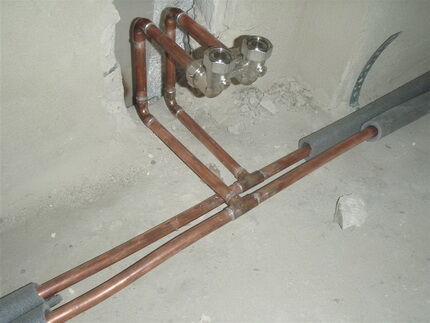
This is worth considering when choosing material for heating or plumbing. In terms of long-term operation, the higher costs are well worth it. In addition to the excellent performance characteristics that copper has, it is quite easy to install. “Scary tales” about difficulties in soldering are most often exaggerated.
Copper is quite easy to solder. Its surface does not require the use of aggressive cleaning agents. Many low-melting metals have high adhesion to it, which simplifies the choice of solder.
Expensive copper fluxes are not needed, since violent reactions with oxygen do not occur when the metal is melted. During the soldering process, the pipe does not deform; its shape and dimensions remain unchanged. The resulting seam can be unsoldered if necessary.
Methods for soldering copper parts
Soldering is considered the best method for joining copper parts. During operation, molten solder fills the small gap between the elements, forming a reliable connection.
There are two most common methods for obtaining such compounds. This is high-temperature and low-temperature capillary soldering. Let's figure out how they differ from each other.
Features of high temperature connections
In this case, the process of joining copper elements takes place at temperatures exceeding +450 degrees. Compositions based on fairly refractory metals: silver or copper are selected as solder.
They provide a durable seam that is resistant to mechanical damage and high temperatures. Such a connection is called solid.
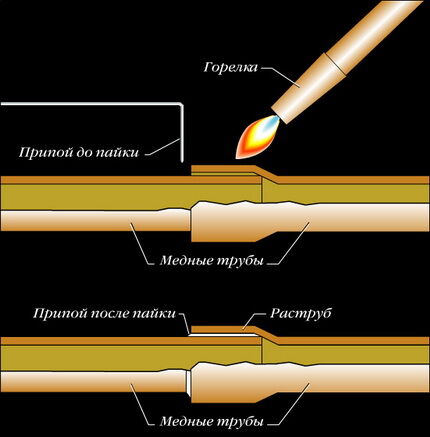
The peculiarity of the so-called hard soldering is the annealing of the metal, which leads to its softening. Therefore, in order for the loss of the strength characteristics of copper to be minimal, the finished weld should be cooled only naturally, without using artificial blowing or immersing the part in cold water.
The solid connection is used for pipes with a diameter of 12 to 159 mm. High temperature brazing is used to connect gas pipes.
In plumbing, it is used in the process of assembling water pipes for monolithic joining of parts whose diameter exceeds 28 mm. In addition, this connection is used in cases where the temperature of the liquid circulating in the pipes can exceed +120 degrees.
High-temperature soldering is also used for assembling heating systems. Its advantage is the possibility of arranging a branch from a previously installed system without first dismantling it.
Low temperature soldering in parts
Soft or low-temperature soldering is the connection of copper parts, during which temperatures below +450C are used. In this case, soft, low-melting metals, such as tin or lead, are selected as solder.
The width of the seam formed by such soldering can vary from 7 to 50 mm. The resulting compound is called soft. It is less durable than hard, but has a number of significant advantages.
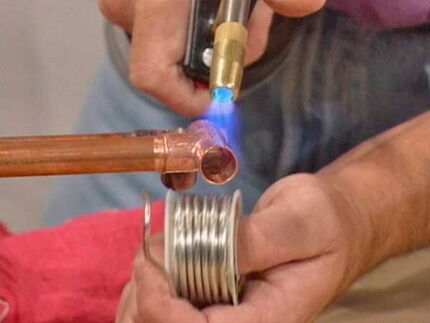
The main difference is that during the soldering process the metal is not annealed. Accordingly, its strength remains the same.
In addition, the temperature during low-temperature soldering is not as high as during high-temperature soldering. Therefore, it is considered safer. So-called soft connections are used for assembling pipes of small diameter: from 6 to 108 mm.
Low temperature connections in plumbing copper pipes are used for the installation of water mains and heating networks, but on condition that the temperature of the liquid circulating in them is less than +130 degrees. For gas pipelines, the use of connections of this type is strictly prohibited.
What will be needed in the process?
To make high-quality connections, you will need special materials and tools. First of all, to treat the pre-cleaned surface of the parts you will need flux. It removes oxides from the base, improves the flow of molten solder and reduces surface tension.
In addition to this, you will also need solder for working with copper. For high-temperature welding, a material is selected that does not contain lead. The packaging must bear the words “lead free” or “lead free”.
For low-temperature soldering, low-melting solder is selected, which may contain tin, copper, bismuth, and silver. Low temperature solder is available in the form of 3mm wire.
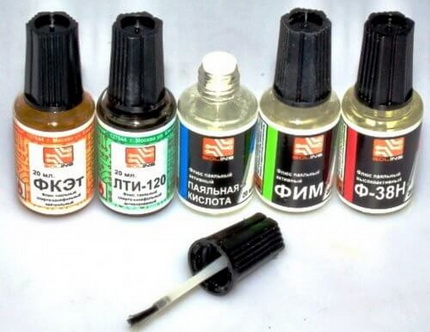
To work you will need tools. First of all, pipe cutter. With its help, you can cut parts to the desired size.It is important to choose a high quality tool so that the soft material, which is copper, does not wrinkle.
You will also need a chamfer remover to remove the burrs. Otherwise, it will be impossible to insert one part into another. A brush or brush is also used to clean the inner surface of the pipes.

Various tools are used to heat copper elements. Most often they choose for low-temperature soldering gas burner, having a narrowly directed flame.
Gas equipment in this case operates from a cylinder with a mixture of propane and butane or with pure butane. One such filling is enough for 3-4 hundred joints.
The device works efficiently; when heated by a burner, the pipe heats up in a few seconds. High-temperature soldering is carried out using gas mixtures of propane-oxygen or acetylene-air.
In addition, soldering can be carried out using a special electric soldering iron designed to work with copper parts. The device can work with both hard and soft solder. The soldering iron is connected to the network and used where it is impossible to work with an open flame. The device is equipped with clamping pliers and removable electrodes.
In addition to these tools, for pipeline installation you will need a marker or pencil, tape measure, hammer and building level.
Soldering technology for copper products
Having prepared the tools and materials, you can begin the soldering process. We perform all operations in the following sequence:
Cut the part to the required length
A variety of tools can be used to cut copper pipes. The most commonly used tool is a manual pipe cutter. To ensure an even cut, hold the pipe only perpendicular to the tool.
We clamp the part between the roller and the blade and rotate the pipe cutter around it. Don’t forget to tighten the adjusting bolt by about a third of a turn after each turn. When using a pipe cutter, the cut will be smooth, and burrs will appear only inside the pipe.

But at the same time, the diameter of the product will decrease slightly, which is undesirable. You can avoid deformation of the part by cutting it with a hacksaw. But in this case, there will be a lot of burrs that will need to be removed, and you will need to use a template to reduce the bevel of the cut.
Crumpling or ovalization of the pipe cut will lead to unpleasant consequences, since it will certainly change the size of the installation gap. Its value should be in the range of 0.02-0.4 mm. If the gap is smaller, solder will not be able to get into it. By increasing the gap, the capillary effect will not appear.
As a result of cutting, the result should be a part with a strictly cylindrical end, having a minimum cut angle. Be sure to remove any burrs from the part, clean its inner surface with a brush and degrease it. We cut the second piece of pipe in the same way. We take a pipe expander and use a hammer to increase the diameter of the second pipe.
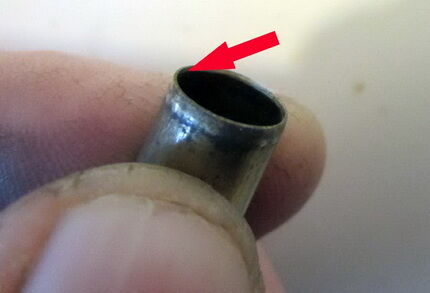
We check how the parts fit into each other, check the dimensions of the resulting installation gap. It must correspond exactly to the norm. We clean and degrease the second part.We carry out the operation over the entire cross-section of the pipe, remembering that the length of the connection must be equal to the diameter of the part.
Apply flux to the surface of the pipe
According to the rules of technology soldering copper pipes, a layer of flux must be applied to the parts. We take the composition and carefully apply it with a brush to the outer surface of the pipe, which will be located inside the joint.
We perform the operation very carefully. We try to collect the minimum amount of solution and completely distribute it over the part. There should be no excess flux left on the surface.
Connecting parts before soldering
Once the flux is applied to the parts, they need to be joined. This must be done quickly enough so that no particles of contaminants get onto the wet surface. If we work with a fitting or a socket, we make a complete connection of the elements.
To do this, rotate them all the way. During the rotation process, the parts not only “fall” into place, but the flux is also distributed over the installation gap as evenly as possible.
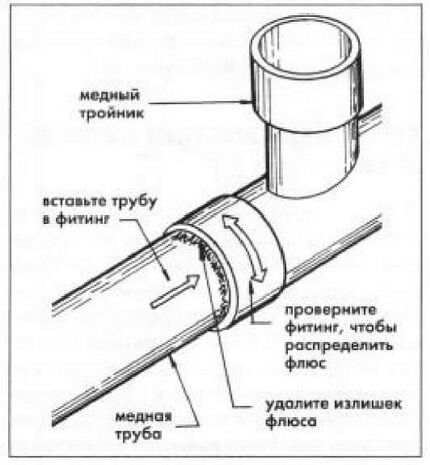
It is prohibited to leave flux on the part, as it is an aggressive chemical composition.
Soldering a tap with a fitting based on a compression ring is carried out in the following order:
Joint formation during low-temperature soldering
When making a soft connection, it is mandatory to use low-melting solder and low-temperature flux. For heating, you can take a standard or small-sized gas burner, which is charged with a mixture of propane and air or propane with butane and air. You can also take a special electric soldering iron.
We take the burner, turn it on and direct the flame to the joint of the pipes. The contact patch located between the flame and the part must be constantly moved. This is necessary to ensure that the elements heat up evenly. We take solder and touch the mounting gap with it from time to time. When heated enough, the solder begins to melt.
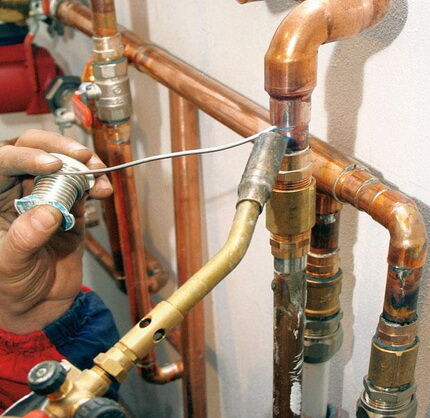
As soon as this happens, move the burner to the side to allow the solder to fill the capillary gap completely. If the solder has not yet begun to melt, continue heating. A feature of low-temperature soldering is that the solder is not specially heated. It should melt from the heat of the heated elements of the connection.
After the solder fills the capillary gap completely, it must be allowed to cool, preferably under natural conditions. It must be remembered that the resulting soft connection has low strength, so touching it while hot is prohibited.
Another important point. During the soldering process, it is extremely important not to overheat the copper. Otherwise, the flux applied to the metal will be destroyed and, accordingly, will not be able to dissolve and remove oxides, which will have a sharply negative effect on the quality of the connection.
Therefore, it is advisable to use flux with solder powder. When the temperature of the part is sufficient to heat the solder, the powder will melt and droplets of the melt will be visible inside the flux.
If the use of a flame is unacceptable for some reason, soldering machines powered by electricity are used. Such equipment is a set of a power supply, electrical tongs and a soldering iron.
The procedure for heating and subsequent formation of a connection with a soldering iron is no different from that described above. The only caveat: it may take less time to fully warm up the parts than when heating with a burner.
Seam formation during high-temperature soldering
In the process of such soldering, a gas burner is also used to heat the parts. It is fueled with a mixture of propane and oxygen or acetylene and air. It is possible to use an acetylene-oxygen mixture.
Experts recommend heating parts evenly and quickly. That is, the heating process should be short. The gas burning in the device should produce a bright blue flame of low intensity.
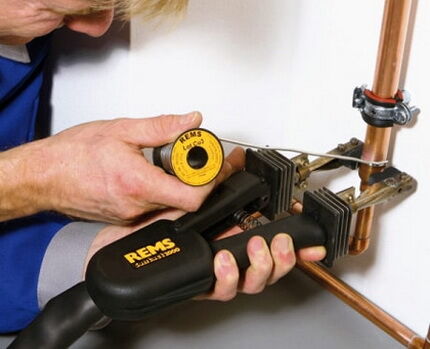
We smoothly move the burner along the future connection so that the heating is as uniform as possible. When the copper heats up to about 750C, it will turn a dark cherry color. At this point, apply solder.
To warm it up better, you can warm it up a little with a burner. But at the same time, we must remember that the solder should melt from the heated parts of the connection, and not from the burner. Ideally, you need to provide the connection with minimal heating, at which the solder will immediately melt and fill the mounting gap the first time.
This may not work right away, but as you gain experience, the result will improve. After completely filling the gap with solder, leave the connection to cool. It is not recommended to touch it at this time. Wipe the cooled seam thoroughly to remove any remaining flux.
Detailed analysis of the technology for soldering copper pipelines using a gas torch given in the article, the contents of which we advise you to familiarize yourself with.
Safety precautions when soldering copper pipes
Novice craftsmen are interested in how to solder copper pipes correctly, but at the same time they forget about safety. This cannot be done. You need to understand that copper has a high thermal conductivity, so you cannot hold the parts in your hands without some kind of protection.
Carelessness and carelessness in copper pipeline assembly may result in a thermal burn. Small elements up to 0.3 m long are handled only with protective gloves or held with pliers.
Caution is also needed when working with flux. This is an extremely aggressive composition. If it gets on your skin during the soldering process, you should immediately stop work and wash the flux off your skin with plenty of soapy water.Otherwise, not only thermal, but also chemical burns may appear on the skin.

Clothes for work also need to be chosen correctly. Synthetic fabrics are absolutely not suitable. Artificial fiber is very sensitive to high temperatures. It melts and catches fire easily, so for work it is best to choose thick clothes made of natural cotton.
Another important point. When the parts are heated, the flux begins to burn. Its vapors are dangerous to humans. For this reason, the room in which soldering of copper pipes is carried out must be well ventilated.
Experienced craftsmen advise those who take up soldering for the first time to first practice on pipe scraps. Practice shows that after three or four independently completed connections, you can already begin installing the pipeline. In this case, it is advisable to assemble the system on the floor and only then start soldering.
The finished pipeline must be rinsed thoroughly with clean hot water to remove solder and flux from the inside of the parts.
Basic mistakes made when soldering
The process of soldering copper pipes is quite simple, but requires some experience. Beginners often make mistakes in their work.
Let's consider the main ones:
- The presence of defects on the surface of the parts being connected. Such defects may appear during the cutting process of the pipe. If soldering is carried out over a defect, the seam will be weak.
- Contamination in the area where elements are connected. Parts must be degreased after cutting and cleaning.
- Insufficient width of the installation gap.According to the rules, for parts with a cross-section from 6 to 108 mm, the gap dimensions should be from 7 to 50 mm.
- Insufficient heating of parts. In this case, the solder will not be able to fuse properly with the substrate. Such a seam will easily break even with a small load.
- Flux does not cover the entire surface of the pipe. Oxides remain on the surface of the part, which negatively affects the quality of the seam.
- Overheating of the connection area. Leads to flux combustion and the formation of oxide and scale. As a result, the quality of the connection deteriorates sharply.
- Checking a hot connection. Before checking the quality of the seam, you need to make sure that the pipe has cooled down. Otherwise, the connection will inevitably deform and lose strength.
- Ignoring safety rules. Soldering is carried out at high temperatures and using aggressive chemicals. Protective clothing, mask and gloves are required.
It may be difficult for a novice master to independently determine the degree of heating of the parts, then it is worth inviting a professional and making the first connections under his guidance.
He will introduce you to the methods of constructing heating circuits from copper pipes. next article, which we recommend that you familiarize yourself with.
Conclusions and useful video on the topic
You can learn more interesting information about soldering copper pipes from the following videos.
Video #1. Features of high temperature copper soldering:
Video #2. How to solder copper fittings correctly:
Video #3. What types of fluxes are there for soldering?
Soldering copper pipes yourself is a useful skill that will definitely come in handy for the home handyman. Copper pipelines serve for a very long time and without problems.Considering the fairly high cost of such parts, you can save a lot on self-assembly and get a high-quality pipeline at a very reasonable price.
Do you have personal experience in connecting copper pipes by soldering? Perhaps you have knowledge about the nuances of carrying out work? Please write comments in the block below, ask questions, share your opinion and photos on the topic of the article.




I very rarely come across copper pipes; very few people actually use them, preferring cheaper and more utilitarian plastic. But I have seen such pipes in houses that claim to be “elite” status. They fit perfectly into the interior there. And I also had to solder them. I can say from personal experience that doing this work is both easy and there are nuances.
Copper is a responsive metal and by itself will not cause you problems. But if you yourself make mistakes, then after some time the place of your soldering will leak. To everyone who is suddenly faced with the need to solder a copper pipe, first of all I will say - do not be lazy and do not waste time on the preparatory work! A good start is half the battle.
If you degrease it poorly, it will leak. If you clean it poorly, it's the same thing. Second: a moderate but sufficient amount of flux. If you regret it, it will leak. Overdo it and you'll end up with an unsightly joint. Third: proper temperature conditions. Overheating and underheating are equally bad. In general, if you are going to solder for the first time, then it is best to find a piece of copper pipe somewhere and practice, as in the draft. At the same time, identify your possible mistakes.